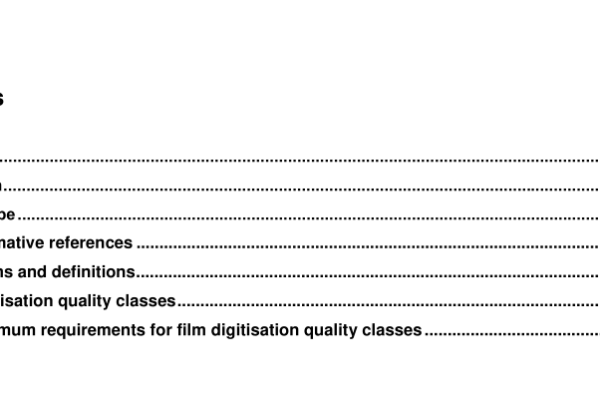ISO 14096-2:2005 pdf download – Non-destructive testing — Qualification of radiographic film digitisation systems — Part 2: Minimum requirements.
1 Scope This European Standard specifies three film-digitisation quality classes for the requirements of non-destructive testing. The selected class depends on the radiation energy, penetrated material thickness and the quality level of the original radiographic film. This European Standard does not address signal processing, display and storage of the digitised data. 2 Normative references This European Standard incorporates by dated or undated reference, provisions from other publications. These normative references are cited at the appropriate places in the text, and the publications are listed hereafter. For dated references, subsequent amendments to or revisions of any of these publications apply to this European Standard only when incorporated in it by amendment or revision. For undated references the latest edition of the publication referred to applies (including amendments). EN 444, Non-destructive testing – General principles for radiographic examination of metallic materials by X- and gamma-rays. EN 1 435, Non-destructive examination of welds — Radiographic examination of welded joints. EN 1 2681 , Founding — Radiographic examination. EN 1 4096-1 , Non-destructive testing — Qualification of radiographic film digitisation systems — Part 1 : Definitions, quantitative measurements of image quality parameters, standard reference film and qualitative control. ISO 5579, Non-destructive testing — Radiographic examination of metallic materials by X- and gamma rays — Basic rules. 3 Terms and definitions For the purposes of this European Standard, the following terms and definitions apply. 3.1 radiographic film digitisation system digitiser sequential application of the two functions below: a) detection of the diffuse transmittance of a small unit area of the film (pixel, picture element) by means of an optical detector, giving an electric output signal (geometrical digitisation); b) conversion of the above electrical signal into a numerical value (densitometrical digitisation) ISO 14096-2:2005(E) EN 14096-2:2003 (E) 5 3.2 pixel size P geometrical centre-to-centre distance between adjacent pixels in a row (horizontal pitch) or column (vertical pitch) of the scanned image
4 Digitisation quality classes All radiographic film digitisation systems are subdivided into 3 quality classes DS, DB and DA : DS – the enhanced technique which performs the digitisation with an insignificant reduction of signal-to-noise- ratio and spatial resolution. Application field: digital archiving of films (digital storage). DB – the enhanced technique, which permits some reduction of image quality. Application field: digital analysis of films, original radiographic films have to be archived. DA – the basic technique, which permits some reduction of image quality and further reduced spatial resolution. Application field: digital analysis of films, original radiographic films have to be archived. Each radiographic film digitisation system for NDT applications shall be identified with all working ranges of optical densities. It shall be classified by the quality class corresponding to Table 1 and the maximum MTF 20 % value, corresponding to EN 1 4096-1 , which can be performed by this system. EXAMPLE A digitisation system of class DS 4,2 (scanner class DS (see Table 1 ), maximum MTF 20 % = 4,2 lp/mm (see Table 2)) can be applied for archiving of radiographs taken with X-rays above 200 keV or ?-rays and can be applied for all class DB and DA digitisation tasks.
ISO 14096-2:2005 pdf download – Non-destructive testing — Qualification of radiographic film digitisation systems — Part 2: Minimum requirements






